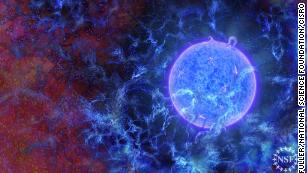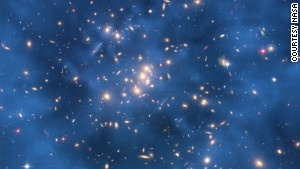It isn't so.
The universe was once entirely dark, with nary a light anywhere throughout the entire cosmos. And then a single star burst into nuclear flame, sundering the void. Then another and another, leading to the stars and galaxies of the familiar universe. In what could well be a stunning breakthrough, a group of astronomers have
announced that they have found radio signals that appear to provide evidence of the first stars to come into existence. And, just to add a bit of spice to the announcement, it's possible that they might have discovered dark matter, a hypothesized substance that has eluded discovery for decades.
Astronomer Avi Loeb, a professor at Harvard University, is
quoted by the Associated Press as saying that "if confirmed, this discovery deserves two Nobel Prizes," one for observing the signal of the first stars and the other for detecting dark matter. He went on to conservatively point out that both claims are extraordinary and require extraordinary evidence. He urged caution.
And this caution is warranted. The observed signal is very small. Radio sources in our own Milky Way galaxy can be 10,000 times stronger than the observed signal. The researchers needed to work very hard to remove this dominant signal. It's like trying to hear someone whispering to you while at a rock concert. If you know the song and vocalist very well, you could -- at least in principle -- mask out the band and recover the whisper. But if the amplifiers had a crackle or the lead singer had a cold, you might get it wrong.
New data could support or falsify this measurement. Observation of the first stars is more likely to be confirmed, with observation of dark matter being less certain. However, if confirmed, it is certainly true that this faint radio signal could be an enormous step forward in our understanding of the birth of the universe.
It's perhaps important to remember that this work is only possible because of publicly funded science. While most people acknowledge the role of science in generating new technologies that improve our lives, publicly funded science has been responsible for discovery after discovery, leading us to an understanding of the world around us that scientists a mere hundred years ago could only dream of.
The birth of the universe
While most people know something of the scientific explanation for how the universe came into existence, not everyone knows the full story of what physics has discovered. Just shy of 14 billion years ago, the universe was created in an event called the
Big Bang.
All of the matter and energy of the visible universe was concentrated into a tiny volume that "exploded," for the lack of a better word, and began expanding. The universe was unimaginably hot, glowing brighter than a steel furnace, with energy converting into matter and back again. Within three minutes, the nuclei of hydrogen and helium had formed, buffeted by an energetic bath of electrons. This swarm of charged particles glowed brightly and yet did not let light pass through it. From the point of view of light, the entire universe was a glowing, yet opaque, wall.
For 380,000 years, the universe expanded and cooled until it reached the temperature of 3,000 Kelvin (about 5,000 °F). At that temperature, hydrogen and helium nuclei could capture electrons, making atoms of hydrogen and helium. And, with that singular event, the universe went dark.
This was the beginning of what are called the Dark Ages. The universe continued to expand and cool, filled with clouds of hydrogen and helium. Gravity took over, with slightly denser areas of the universe pulling the gas into denser and denser clumps. While the universe on the whole was cooling, the temperature at the center of these clumps was rising; after about 180 million years eventually becoming so high that the gas started to experience nuclear fusion.
And the first stars were born.
Now it turns out that it is not so easy to directly see the light of those distant stars. After all, they were embedded in clouds of cool hydrogen gas that absorbed the light. And it was with that absorption that they revealed themselves. While hydrogen absorbed the light of the stars, it re-emitted that energy in an easily identifiable way.
Young stars burn hot and emit lots of ultraviolet light -- the same kind that gives you a sunburn. Hydrogen gas absorbs the light and knocks the electrons into higher energy orbits. Eventually the electrons lose energy and they settle back into the lowest orbit in one of two configurations.
Hydrogen consists of one proton and one electron and both particles act like little magnets, with a north pole and a south pole. In an atom of hydrogen, the north poles of the proton and electron can point in the same or opposite direction. If they point in opposite directions, that's the end of the line -- they are in a stable configuration. But if the north poles point in the same direction, they'll stay that way for a short time, and then the north pole of the electron will flip and point in the direction opposite to the proton. This is exactly what happens with ordinary magnets.
When the electron flips, it emits a characteristic wavelength (21 cm or 1420 MHz, approximately the same frequency as 4G cellular service). By detecting that radiation, scientists could indirectly detect the existence of the early stars.
The Big Bang caused the universe to expand, which has the consequence of stretching the wavelength of the radiation emitted by hydrogen and decreasing the frequency. Today, this radiation is only about 78 MHz, or just below the range of FM radio.
By studying the sky's spectrum, astronomers determined that the period of time that the stars were heating the hydrogen gas clouds ranged from about 180 million to 260 million years after the Big Bang. After 260 million years, the gas had heated enough to be transparent to the light from stars. To give some perspective of the magnitude of the achievement, the Hubble Space Telescope has only been able to directly image galaxies that existed no earlier than 400 million years after the Big Bang. This discovery has cut in half the period of the universe for which we previously had no data.
The role of dark matter
While seeing evidence for the very first stars is exciting enough, there is another consequence of this research that might well be paradigm-changing. The size of the observed signal is twice as big as predictions. This means that either the gas of the early universe was much colder than expected, or the residual background radiation from the Big Bang was much hotter.
So, which was it? Truthfully, scientists don't know. It appears to be that the hydrogen gas cooled much more effectively than can be explained by current theories. Several possible explanations were tested and the one that the authors claim to be most probable is that the early hydrogen gas interacted more strongly than expected with
dark matter.
Dark matter is a proposed substance that explains many astronomical anomalies, like galaxies that rotate too quickly to be explained by the gravity of observed matter and even clusters of dozens or hundreds of galaxies that are moving so quickly that they shouldn't be bound together. Dark matter doesn't interact with light or any electromagnetic radiation and only makes its presence known through its gravitational interactions. If dark matter interacted with ordinary matter in the early universe, it could cool off the gas and this would explain the reported discrepancy.
As with all extraordinary claims, the key is verification by independent researchers. And, until confirmation is found, it is important to be skeptical. Other astronomers will attempt to replicate the measurement.
And new technology may come in handy. There is a telescope planned, called the James Webb Space Telescope (JWST), which was designed by a consortium of NASA and the Canadian and European space agencies. It is designed to directly measure light from very early stars, whose wavelength has been shifted to longer wavelengths by the expansion of the universe. JWST is the successor for the Hubble telescope and it is expected to revolutionize astronomy to the same degree that the Hubble telescope did. JWST is scheduled to launch in about 18 months.
















No comments:
Post a Comment